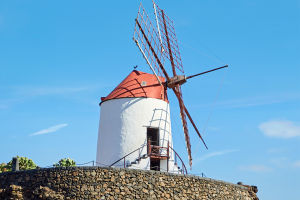The Canary Islands are a treasure trove of diverse experiences. From volcanic landscapes and pristine beaches to bustling markets and gastronomic delights, there’s something for everyone.
Dear Lykkers. The islands also boast two UNESCO geoparks and a growing focus on sustainable tourism, making them ideal for eco-conscious travelers.
Lanzarote
Beyond its resort towns, Lanzarote means wild coasts, white-walled villages, rust-red volcanic cones, swirling bougainvillaea, and buzzy farmers’ markets. It also has lively arts and gastronomy scenes. The entire island is a UNESCO geopark.
What to do
Base yourself in the rugged north, where low-key fishing villages – Arrieta, Punta Mujeres, La Santa, Órzola – and major works by the Lanzarote-born artist César Manrique await, including the Casa-Museo César Manrique (in leafy, historical Haría) and the Jameos del Agua. Inland, Teguise was Lanzarote’s capital until 1852; its protected historical core is packed with ancient mansions, fanning out from a restored 15th-century cathedral. The nearby village of Teseguite has classic Canarian architecture, a 17th-century chapel, and a couple of wonderful pottery workshops.
For the lunar-like Parque Nacional de Timanfaya, sidestep the crowds by hiking the coastal Ruta del Litoral path, or hop over into the Parque Natural de los Volcanes.
Surf-friendly Famara beach in the north is one of the Canaries’ most beautiful, and you can do day trips to the dazzling beaches at Punta del Papagayo in the south. Don’t miss the natural pools in Punta Mujeres and, time permitting, all-natural Playa del Risco (accessible by a one-hour hike) or Los Caletones coves near Órzola.
Where to stay
With its island-inspired boutique design, circular pool, and divine breakfasts, Álava Suites (doubles from €110) in Costa Teguise is a great place to tap into the local creative scene. Lanzarote Retreats (doubles/rentals from €115/95) has stylish yurts, stone-built cottages, and a solar-warmed pool at its eco-finca in Arrieta.
Eat and drink
People travel from all over Lanzarote for fresh grilled fish, seafood paella, and other local delights at Casa de la Playa, overlooking Arrieta’s beach (mains €10-€15). Bar La Piscina, by the Punta Mujeres pools, is a go-to for typical tapas (chunky tortilla, seafood salpicón) at around €3-€10. La Santa’s Alma Tapas & + is a favourite for its creative, market-based small plates (€8-€15), which might include ossobuco cannelloni.
Isla Graciosa
Off northern Lanzarote and reachable only by ferry from Órzola, sand-dusted Graciosa is a go-slow, back-to-nature escape. It became the official eighth Canary Island in 2018.
What to do
Cycle to Caribbean-worthy Playa de las Conchas, hike up Las Agujas Grandes or Montaña Amarilla volcanoes, swim at golden Playa Francesa, and wander the “capital,” Caleta de Sebo, with its views of Lanzarote’s Famara cliffs. La Graciosa sits within the Parque Natural del Archipiélago Chinijo, which protects various uninhabited surrounding islets known for their rich birdlife; explore them with conservation-focused Eco-Insider.
Where to stay
Family-owned Pensión Enriqueta (+34 928 842 051, doubles €35) is one of La Graciosa’s tourism pioneers, with cheery, rustic rooms in Caleta de Sebo.
Eat and drink
El Marinero, is a locally loved tapas haunt serving home-cooked tortilla and seafood rice dishes (up to €10). Or try a platter of Lanzarote goat’s cheese at beachside Casa Margucha/Restaurante Girasol (tapas €10-€20).
Fuerteventura
With its salty breezes, renowned surf, volcanic landscapes, and honey-gold coastline, Fuerteventura is the Canaries’ destination for beach bliss.
What to do
Stay in northern Fuerteventura to soak up the surf vibe in El Cotillo, Corralejo, and Lajares, hike to tiny, beach-side Majanicho, take a day trip to the near-deserted Isla de Lobos (for snorkelling, paddleboarding, and more), and get away from it all in the dune-lined Parque Natural de Corralejo. Around 15km south of Corralejo, La Oliva is known for its historical architecture and the Centro de Arte Canario Casa Mané, devoted to Canarian greats.


